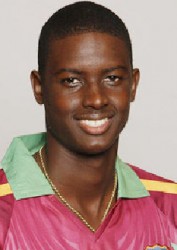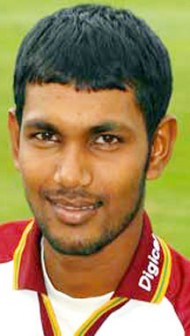Of all contributing factors to the West Indies Under-19 cricket team’s success at the just concluded World Cup, Shimron Hetmyer’s captaincy stands out for its excellence.
![]() No doubt, the batsmen, bowlers, fielding, and coaching staff were equally important to the team winning the Region’s first junior World Cup crown, but Hetmyer’s commanding performance marshalling his troops in Bangladesh was, a cut above anything else enjoyed by West indies teams for several years.
No doubt, the batsmen, bowlers, fielding, and coaching staff were equally important to the team winning the Region’s first junior World Cup crown, but Hetmyer’s commanding performance marshalling his troops in Bangladesh was, a cut above anything else enjoyed by West indies teams for several years.
The struggles by the West Indies Cricket Board (WICB) to unearth a worthy leader for its senior teams have become the butt of jokes of late, as five players have been used at the helm of the Test and One Day International squads, in the last five years.

In comparing Hetmyer’s performance to Chris Gayle’s, Darren Sammy’s, Denish Ramdin’s, Dwayne Bravo’s and Jason Holder’s, one would appreciate why, among other factors, West Indies teams have been consistent failures in international competition for so long.
The young Berbician’s use of his bowlers and field placing improved significantly during the Under-19s six-match ride to the title, but his motivational approach to his players on the field was spot-on from match one.
Hetmyer was constantly communicating with his charges, cheering, admonishing and signaling after almost after every delivery, keeping everyone focused on giving 100 percent to make catches, charge across the field with energy and enthusiasm while delivering wicket-taking deliveries.

His impact was so obvious, television producers replayed brief clips of Hetmyer’s actions in the field during the semi-final against Bangladesh, drawing rave reviews from former international players Daryll Culinan and Russell Arnold among others in the analysts box.
Not since Vivian Richards led West Indies to an unbeaten seven -year stretch of Test series success in the 1984-91 period, has any Regional team captain led with such command for resulting success.
With Hetmyer in charge, the laid back type Gayle approach was missing as was that of the tactically weak and ever smiling Sammy, whether a six was hit or a catch dropped, or the withdrawn Bravo and Ramdin styles or the reluctant leader in Holder.
You saw a captain profoundly serious in his work and not shy to vent his feelings one way of the other depending on the course of events on the field.
It was the type of body language you see in successful leaders whether it was Richards in the 1980s, Le Bron James on the basketball court or Franz Beckenbauer of yesteryear on the football field.
If one wants to debate the pros and cons of West Indies’ Twenty20 World Cup title win with Sammy as captain, three and a half years ago, it is easy to conclude his strategic input had little to do with the success, if the team’s progress was followed closely in 2012. In the shortest form of the game, the difference between winning and losing could hinge on one big hitting innings as was Marlon Samuels’s hurricane knock in the final or a solitary incisive bowling spell. And with the likes of ball bashers in Gayle and Keiron Pollard included along with number one ranked T20 bowler at the time Sunil Narine, anything was possible for the Windies in Sri Lanka.
Effective execution on the field for the Young Windies in Bangladesh, however, could’ve not been had without the coaching staff’s role, led by Graeme West
Among West Indian fans West is unknown, but after whipping the team into peak form at the utmost ideal time, he is now much more than just another foreign coach. In unassuming manner West grew the team from strength to strength from a struggling lineup that was whitewashed by the tournament hosts in three warm-up games on arrival in Bangladesh, to eventually conquering the three best sub continent teams in their own backyard.
In disposing of Pakistan, Bangladesh and India in back to back clashes in the knockout stages, Young Windies pulled off an unprecedented achievement for any visiting team at junior or senior levels in Asia, one of the most challenging places to compete.
In energy sapping heat and humidity the Young Windies never stopped taking match- winning catches and making energetic ground fielding. If India was that sharp in the field during the final, the result could’ve been different.
Fast bowler Chemar Holder’s inclusion halfway into the competition as an injury replacement was a big difference too for the champions. He was thrust into the starting lineup immediately after arrival for the quarterfinal, and not deposited on the bench as was the case with Miguel Cummings, the most productive paceman in the ongoing Regional four-day series at the time, during the senior team’s Australian year-end tour.
Holder’s display in the Nagico Cup 50 -overs series got his name into the conversation among promising young bowlers, and quite rightly there was no dithering by the selectors in making him the pace partner of the potent Alzarri Joseph.
Again, if West and company had taken the flawed conservative approach of the decision makers of the Test team in Australia, we might’ve not been singing the junior squad’s praises today.
Given its track record of the past of negligence, it is now a big challenge for the WICB to build on the youngsters’ success.
Even though Hetmeyer’s leadership skills cannot desert him overnight, the other components of Young West Indies’ success story, can disappear as fast as the next Caribbean sunset.
If Joseph, Holder and every other team member are not groomed the correct way for longevity of success in their careers, this World Cup triumph could easily become another flash-in-the pan accomplishment.
The team chemistry could last forever, but appetite for hard training has to be developed for them and every other promising young West Indian.
Joseph seems to have all the makings of an emerging international world class fast bowler. He has the speed, accuracy and technique, allied by his six-foot plus frame. His personal training regimen is not public knowledge, but as his intensity dropped in the final, you got the impression he needs to be put in the hands of someone who’s been there and done that.
His Antiguan compatriot Andy Roberts immediately comes to mind, whose skill, strength and stamina were the hallmarks of that feared four-prong pace attack, he helped terrorize the world with, for 15 years back in the 1970s and 80s.
The batsmen have to be aided in developing the Shivnarine Chanderpaul type dedication of long net session hours for technique improvement.
It would be the greatest tragedy in Regional sport if the West Indies Cricket Board, repeats its fallacy of the post 1980s when it was believed similar replacements for that Dream Team would simply drop out of the sky, without any regard for development programmes.
If ever the WICB needs to note and follow-up on any decision it endorsed for any team, the time is now following the Hetmyer led squad’s surprising Cup triumph.





